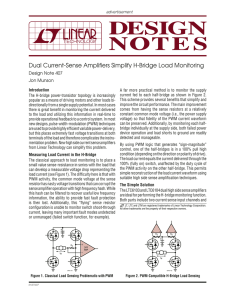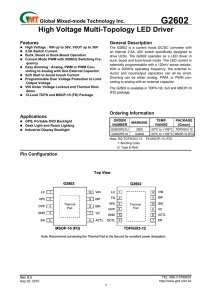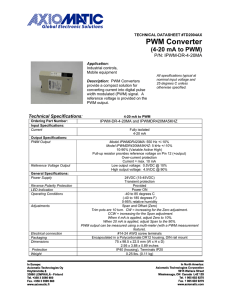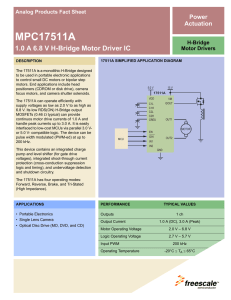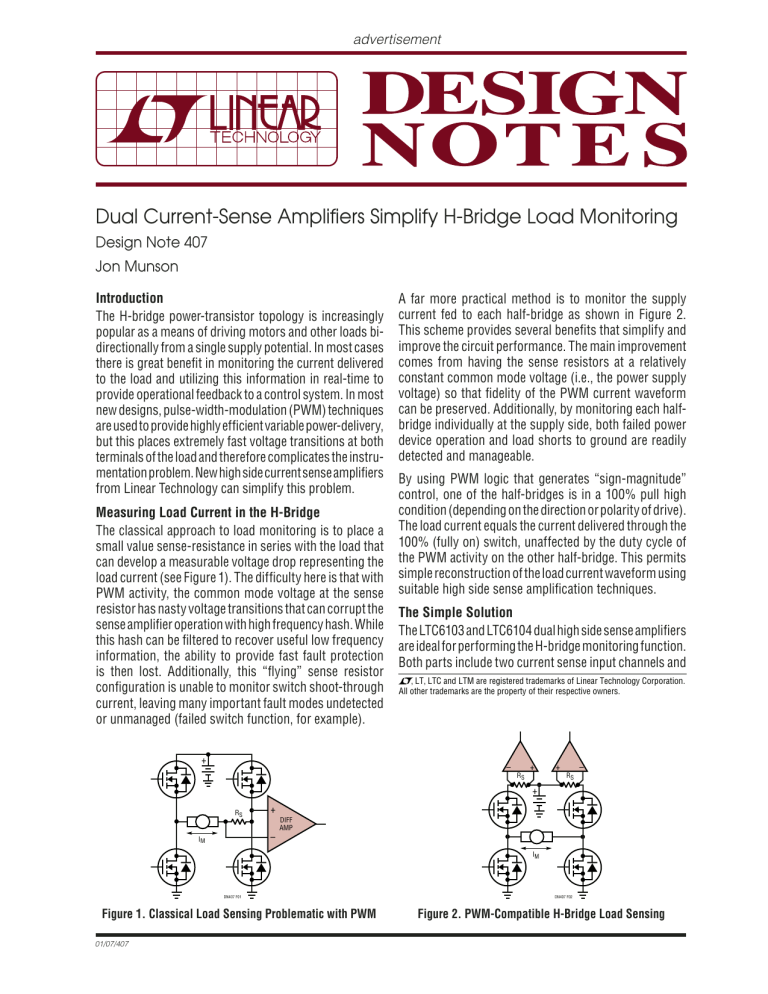
advertisement Dual Current-Sense Amplifiers Simplify H-Bridge Load Monitoring Design Note 407 Jon Munson Introduction The H-bridge power-transistor topology is increasingly popular as a means of driving motors and other loads bidirectionally from a single supply potential. In most cases there is great benefit in monitoring the current delivered to the load and utilizing this information in real-time to provide operational feedback to a control system. In most new designs, pulse-width-modulation (PWM) techniques are used to provide highly efficient variable power-delivery, but this places extremely fast voltage transitions at both terminals of the load and therefore complicates the instrumentation problem. New high side current sense amplifiers from Linear Technology can simplify this problem. Measuring Load Current in the H-Bridge The classical approach to load monitoring is to place a small value sense-resistance in series with the load that can develop a measurable voltage drop representing the load current (see Figure 1). The difficulty here is that with PWM activity, the common mode voltage at the sense resistor has nasty voltage transitions that can corrupt the sense amplifier operation with high frequency hash. While this hash can be filtered to recover useful low frequency information, the ability to provide fast fault protection is then lost. Additionally, this “flying” sense resistor configuration is unable to monitor switch shoot-through current, leaving many important fault modes undetected or unmanaged (failed switch function, for example). + A far more practical method is to monitor the supply current fed to each half-bridge as shown in Figure 2. This scheme provides several benefits that simplify and improve the circuit performance. The main improvement comes from having the sense resistors at a relatively constant common mode voltage (i.e., the power supply voltage) so that fidelity of the PWM current waveform can be preserved. Additionally, by monitoring each halfbridge individually at the supply side, both failed power device operation and load shorts to ground are readily detected and manageable. By using PWM logic that generates “sign-magnitude” control, one of the half-bridges is in a 100% pull high condition (depending on the direction or polarity of drive). The load current equals the current delivered through the 100% (fully on) switch, unaffected by the duty cycle of the PWM activity on the other half-bridge. This permits simple reconstruction of the load current waveform using suitable high side sense amplification techniques. The Simple Solution The LTC6103 and LTC6104 dual high side sense amplifiers are ideal for performing the H-bridge monitoring function. Both parts include two current sense input channels and , LT, LTC and LTM are registered trademarks of Linear Technology Corporation. All other trademarks are the property of their respective owners. + – RS + – RS + RS + DIFF AMP – IM IM DN407 F01 Figure 1. Classical Load Sensing Problematic with PWM 01/07/407 DN407 F02 Figure 2. PWM-Compatible H-Bridge Load Sensing furnish either two unidirectional outputs (LTC6103) or a single bidirectional output (LTC6104). Since each current sense channel operates in a unidirectional fashion, only the current from the fully on half-bridge is monitored. Since the current pulses in the other half-bridge are in the opposite direction, that amplifier channel remains in a cutoff condition and does not impact the reading. This means that the output signals only reflect the fully-on half-bridge current, which is identical to the controlled load current. With their fast (microsecond level) response times, these parts also offer overload sensing, thereby providing the ability to signal power device protection circuits in the event of fault conditions. Both parts are furnished in tiny MSOP-8 packages for compact layouts and can operate with up to 60V power supply potentials. With their 70V transient capability, the need for additional surge suppression components is eliminated in harsh automotive applications. The dual outputs of the LTC6103 can be used individually to provide overload detection, and/or may be taken as a differential pair to provide a bidirectional signal to an analog-to-digital converter (ADC) for example. Figure 3 shows a typical circuit for a generic H-bridge application. The power devices may be complementary MOSFETs, pure N-MOSFETs, or other switching devices. When the bridge drives the load (a motor assumed in the example shown), one of the LTC6103 outputs rises above ground, while the other remains pulled down to ground, thereby forming an accurate bidirectional differential output with a common mode voltage that never falls below ground. The selection of output resistance (4.99k in the example) can be scaled to satisfy the source-impedance requirement of any ADC. As an alternative, the output structure of the LTC6104 provides a single bidirectional signal. The output connection can either source or sink current to a load resistance, depending on which input channel is sensing current flow. A negative-going output swing remains linear as long as Pin 4 (V–) is lower than the lowest expected output level by at least 0.5V. This condition is met if the load resistance is returned to a suitable reference voltage while Pin 4 is grounded (as shown in the Figure 4 example). The output resistance could also be returned directly to ground to form a true bipolar output if Pin 4 is tied to a suitable negative supply, such as –3V. Conclusion Designing a load current monitor for an H-bridge power driver is not difficult if you have the right amplifier. The LTC6103 and LTC6104 fit the bill. They include dual sense inputs and a choice of two different output configurations—features that reduce complexity and printed circuit area. 3V TO 18V 0.1µF VBATTERY (4V TO 60V) VBATTERY (6V TO 60V) 200Ω 10m 7 6 8 200Ω 5 LTC6103 1 10m DIFFERENTIAL OUTPUT = ±2.5V FS (±10A FS) 10m 249Ω 7 6 8 4.99k 4 1µF LT1790-2.5 + 2 4 249Ω 10m 1 6 2 4.99k 5 LTC6104 VO 2 – VO = 2.5V ±2V (±10A FS) 4 4.99k PWM* PWM* PWM* PWM* IM IM DN407 F03 *USE "SIGN-MAGNITUDE" PWM FOR ACCURATE LOAD CURRENT CONTROL AND MEASUREMENT Figure 3. LTC6103 Provides Bidirectional H-Bridge Monitoring with ADC-Friendly Differential Output DN407 F04 *USE "SIGN-MAGNITUDE" PWM FOR ACCURATE LOAD CURRENT CONTROL AND MEASUREMENT Figure 4. LTC6104 Provides Bidirectional H-Bridge Monitoring with Single-Ended Output Data Sheet Download For applications help, call (408) 432-1900, Ext. 2020 www.linear.com Linear Technology Corporation dn407f LT/TP 0107 409K • PRINTED IN THE USA FAX: (408) 434-0507 ● www.linear.com © LINEAR TECHNOLOGY CORPORATION 2006 1630 McCarthy Blvd., Milpitas, CA 95035-7417 (408) 432-1900 ●
